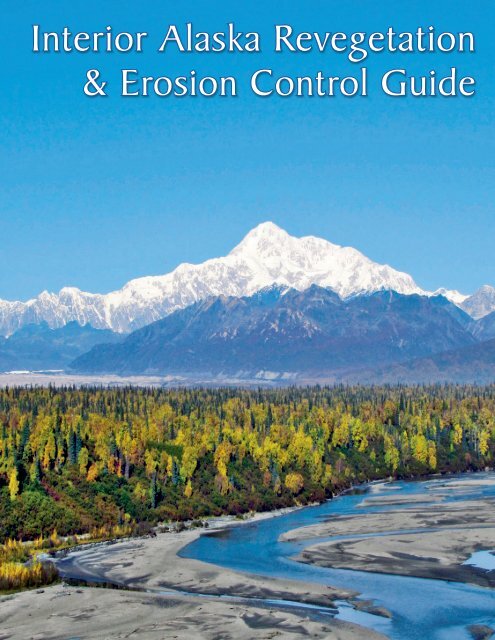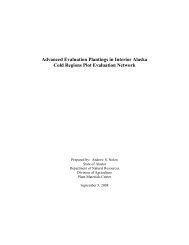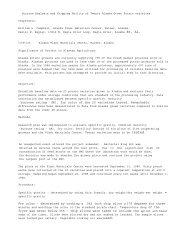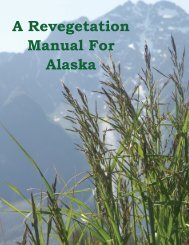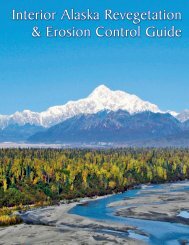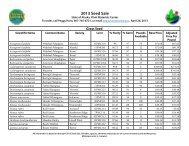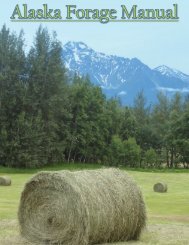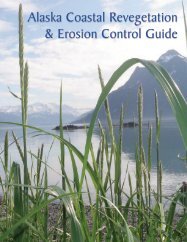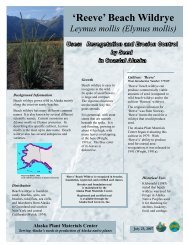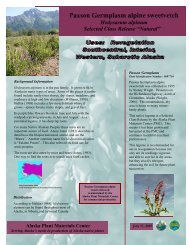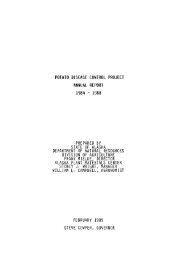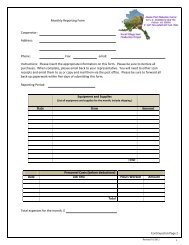download (5 mb) - Alaska Plant Materials Center - State of Alaska
download (5 mb) - Alaska Plant Materials Center - State of Alaska
download (5 mb) - Alaska Plant Materials Center - State of Alaska
You also want an ePaper? Increase the reach of your titles
YUMPU automatically turns print PDFs into web optimized ePapers that Google loves.
Interior <strong>Alaska</strong> Revegetation<br />
& Erosion Control Guide
Interior <strong>Alaska</strong>, for the purposes<br />
<strong>of</strong> this guide, is defined<br />
as the 37 USGS quads shown<br />
above. These quads span<br />
several unique eco-regions,<br />
further detailed on page 49.<br />
Front Cover: The Chulitna River meanders in front <strong>of</strong> the <strong>Alaska</strong> Range<br />
Cover Photo: Phil Czapla (AK PMC)
Interior <strong>Alaska</strong> Revegetation<br />
& Erosion Control Guide<br />
By<br />
Philip K. Czapla<br />
and<br />
Stoney J. Wright<br />
Editing | Layout | Design: Brennan Veith Low<br />
i
Any use <strong>of</strong> trade, firm, or product names is for descriptive<br />
purposes only and does not imply endorsement by any employee<br />
or branch <strong>of</strong> the <strong>State</strong> <strong>of</strong> <strong>Alaska</strong>. Information submitted by private<br />
companies in the case studies section <strong>of</strong> this document is publicly<br />
available, and presented for educational purposes. All photographs<br />
are copyright <strong>of</strong> their respective owners.<br />
Published July, 2012:<br />
<strong>State</strong> <strong>of</strong> <strong>Alaska</strong><br />
Department <strong>of</strong> Natural Resources<br />
Division <strong>of</strong> Agriculture<br />
<strong>Alaska</strong> <strong>Plant</strong> <strong>Materials</strong> <strong>Center</strong><br />
5310 S. Bodenburg Spur Rd.<br />
Palmer, AK 99645<br />
This publication was funded<br />
in part by a grant from the<br />
United <strong>State</strong>s Department <strong>of</strong><br />
Agriculture, Natural Resource<br />
Conservation Service.<br />
<strong>Alaska</strong> <strong>Plant</strong> <strong>Materials</strong> <strong>Center</strong> logo: ‘Germinate’ - Original artwork by Sheila Wyne, used with permission<br />
ii
Foreword<br />
iii
Author’s Preface<br />
SEAN PARNELL, GOVERNOR<br />
CENTRAL OFFICE<br />
1800 GLENN HIGHWAY, SUITE 12<br />
PALMER, ALASKA 99645-6736<br />
DEPARTMENT OF NATURAL RESOURCES PHONE: (907) 745-7200<br />
FAX: (907) 745-7112<br />
DIVISION OF AGRICULTURE X<br />
NORTHERN REGION OFFICE<br />
1648 S. CUSHMAN ST., # 201<br />
FAIRBANKS, ALASKA 99701-6206<br />
PHONE: (907) 328-1950<br />
FAX: (907) 328-1951<br />
X<br />
PLANT MATERIALS CENTER<br />
5310 S. BODENBURG SPUR<br />
PALMER, ALASKA 99645-9706<br />
PHONE: (907) 745-4469<br />
FAX: (907) 746-1568<br />
The publishing <strong>of</strong> the Interior <strong>Alaska</strong> Revegetation and Erosion Control Guide marks my<br />
thirty-third year with the <strong>Alaska</strong> <strong>Plant</strong> <strong>Materials</strong> <strong>Center</strong>. Much <strong>of</strong> the early <strong>of</strong>f-site plot evaluation<br />
work and revegetation studies during my career took place in <strong>Alaska</strong>’s Interior. A shift to work on<br />
coastal regions occurred after roughly eight years, in part due to the increasing amount <strong>of</strong><br />
construction activity in the coastal areas <strong>of</strong> <strong>Alaska</strong>, and the availability <strong>of</strong> federal funds for coastal<br />
projects.<br />
Another reason revegetation and restoration activities in <strong>Alaska</strong>’s Interior subsided was the<br />
fact that many disturbances self-restore. On non-fill disturbances, natural revegetation was fast<br />
and generally reliable. Revegetation in the Interior was required only when erosion potential was<br />
high and there was insufficient time to rely on natural revegetation. Highway and airport<br />
construction activities over the past two decades have kept the <strong>Plant</strong> <strong>Materials</strong> <strong>Center</strong> involved in<br />
the other revegetation efforts in the Interior.<br />
Although the Interior allows for greater use <strong>of</strong> natural revegetation than other areas <strong>of</strong><br />
<strong>Alaska</strong>, the region is not immune to the problems associated with surface disturbances.<br />
Permafrost poses unique and interesting problems when disturbed by construction and mining.<br />
The massive forest fires so common in the Interior also present water quality issues if erosion<br />
occurs after the fire and before natural revegetation can occur.<br />
Working on projects in the Interior has left me with a nu<strong>mb</strong>er <strong>of</strong> great memories <strong>of</strong><br />
successful projects and the outstanding summers in the region. Interior <strong>Alaska</strong> is a unique place.<br />
Hopefully this guide will assist others in their efforts to use vegetation to control erosion problems<br />
and restore disturbed lands to a natural condition.<br />
The science <strong>of</strong> revegetation in <strong>Alaska</strong>’s Interior is moving forward in a new direction. The<br />
seeding practice may be different, but erosion control and storm water issues remain important<br />
and must be accommodated during the entire process. This new seeding approach will be<br />
cautiously introduced so the techniques can be adapted to the rest <strong>of</strong> <strong>Alaska</strong>, advancing the<br />
science even more. May the effort begin!<br />
Stoney J. Wright<br />
“Responsibly develop <strong>Alaska</strong>’s resources by making them available for<br />
maximum use and benefit consistent with the public interest.”<br />
iv
Author’s Preface<br />
v
Acknowledgements<br />
This guide was written to assist land owners, land managers, engineers<br />
and environmental pr<strong>of</strong>essionals in making decisions regarding<br />
revegetation and the use <strong>of</strong> vegetation in soil erosion control and soil conservation.<br />
The information contained in the guide builds upon past revegetation<br />
manuals including:<br />
2001 <strong>Alaska</strong> Highway Drainage Manual - Chapter 16: Erosion and<br />
Sediment Control. (2001) <strong>State</strong> <strong>of</strong> <strong>Alaska</strong>, Department <strong>of</strong> Transportation<br />
and Public Facilities.<br />
Wright, Stoney J. (2008) - A Revegetation Manual for <strong>Alaska</strong>. Edited<br />
by Peggy Hunt. <strong>State</strong> <strong>of</strong> <strong>Alaska</strong>, Department <strong>of</strong> Natural Resources, Division<br />
<strong>of</strong> Agriculture, <strong>Alaska</strong> <strong>Plant</strong> <strong>Materials</strong> <strong>Center</strong>.<br />
Wright, Stoney J. & Czapla, Philip K. (2011) - <strong>Alaska</strong> Coastal Revegetation<br />
and Erosion Control Guide, 2 nd Edition. Edited by Brennan<br />
Veith Low. <strong>State</strong> <strong>of</strong> <strong>Alaska</strong>, Department <strong>of</strong> Natural Resources, Division<br />
<strong>of</strong> Agriculture, <strong>Alaska</strong> <strong>Plant</strong> <strong>Materials</strong> <strong>Center</strong>.<br />
The authors would like to thank the individuals named below for their<br />
participation in this project.<br />
Dean Brown with the <strong>Alaska</strong> Department <strong>of</strong> Natural Resources (DNR),<br />
Division <strong>of</strong> Forestry, Casey Dinkel with the <strong>Alaska</strong> DNR, Division <strong>of</strong> Agriculture,<br />
<strong>Alaska</strong> <strong>Plant</strong> <strong>Materials</strong> <strong>Center</strong>, Lee McKinley with the <strong>Alaska</strong> Department<br />
<strong>of</strong> Fish & Game and Anne Brown with the <strong>Alaska</strong> DNR, <strong>State</strong><br />
Pipeline Coordinator’s Office.<br />
vi
Table <strong>of</strong> Contents<br />
Interior <strong>Alaska</strong> Revegetation & Erosion Control Guide<br />
Photo: Casey Dinkel (AK PMC)<br />
The Trans-<strong>Alaska</strong> Pipeline winds through mixed hardwood and spruce forest in Interior <strong>Alaska</strong>.<br />
Section 1: Background<br />
Introduction<br />
• Geography<br />
• History<br />
• Impacts<br />
• Purpose<br />
........................ 2<br />
....................................<br />
....................................<br />
....................................<br />
....................................<br />
vii
Section 2: Project Implementation<br />
Planning<br />
• Goal Setting & Preparation<br />
• Identify Site Conditions<br />
• Seeding Methods<br />
• Transplanting<br />
• <strong>Plant</strong>ing Choices<br />
• <strong>Plant</strong>ing Time<br />
• Selection <strong>of</strong> Species<br />
• Mulch & Erosion Matting<br />
Techniques<br />
• Charged Overburden Veneer<br />
• Sod Clumps<br />
• Vegetation Mats<br />
• Natural Reinvasion<br />
• Enhanced Natural Reinvasion<br />
• Imprinting<br />
• Scarification<br />
• Dormant Seeding<br />
Wild Seed Collection<br />
Potential Sources <strong>of</strong> Erosion<br />
• Wildfire<br />
• Agriculture<br />
• Transportation<br />
• Riverbank Erosion<br />
• Mining<br />
Conservation & Protection<br />
• Protecting Wetland Areas<br />
• Invasive Species<br />
• Permafrost Conservation<br />
........................6<br />
....................................<br />
....................................<br />
....................................<br />
....................................<br />
....................................<br />
....................................<br />
....................................<br />
....................................<br />
...................... 18<br />
...................................<br />
...................................<br />
...................................<br />
...................................<br />
...................................<br />
...................................<br />
...................................<br />
...................................<br />
..................... 32<br />
..................... 36<br />
...................................<br />
...................................<br />
..................................<br />
..................................<br />
...................................<br />
..................... 42<br />
...................................<br />
...................................<br />
...................................<br />
viii
Section 3: Species Selection<br />
Adapted <strong>Plant</strong>s<br />
• Eco-regions <strong>of</strong> <strong>Alaska</strong><br />
• Vegetation Communities<br />
• Revegetation Suggestions<br />
<strong>Plant</strong> Species<br />
..................... 48<br />
...................................<br />
...................................<br />
...................................<br />
..................... 54<br />
Section 4: Case Studies<br />
Revegetation Projects<br />
• True North Mine Reclamation<br />
• Chistochina River Wetland Restoration<br />
• Kanuti Pit Rehabilitation<br />
• Fairbanks Partial Landfill Closure<br />
• Riparian Reclamation <strong>of</strong> Nome Creek<br />
• Illinois Creek Mine Site Revegetation<br />
......................83<br />
...................................<br />
...................................<br />
...................................<br />
...................................<br />
...................................<br />
...................................<br />
Section 5: Further Information<br />
Works Cited<br />
Appendix A: Seed Regulations<br />
Appendix B: Partner Agencies<br />
.....................110<br />
....................................<br />
....................................<br />
ix
Background<br />
Photo: Phil Czapla (AK PMC)<br />
Section 1:<br />
Interior <strong>Alaska</strong> is dominated by boreal spruce forests, with wetlands present throughout.<br />
The <strong>Alaska</strong> Range is visible in the background <strong>of</strong> this photo, taken near Talkeetna.<br />
Introduction<br />
• Geography<br />
• History<br />
• Impacts<br />
• Purpose<br />
1
Introduction<br />
Photo: Brianne Blackburn (AK PMC)<br />
Spruce, willow and fireweed are present in this Brooks Range vegetation community.<br />
Geography<br />
Interior <strong>Alaska</strong> is a region defined by three mountain ranges; the Brooks<br />
Range to the north, the Chugach to the south, and the <strong>Alaska</strong> Range in between.<br />
“[Interior <strong>Alaska</strong>] includes North America’s highest mountain, permanently snow<br />
covered peaks, glaciers, rivers and streams, lakes, a diverse geology and vegetation<br />
that ranges from Alpine tundra to boreal forest and wetlands, and a rich<br />
flora and fauna” (Laursen & Seppelt, 2009).<br />
<strong>Alaska</strong> is by far the largest state within the United <strong>State</strong>s <strong>of</strong> America; having<br />
more than twice the area <strong>of</strong> its nearest largest state. Indeed, <strong>Alaska</strong> by itself covers<br />
1% <strong>of</strong> the land mass on Earth, and is larger than all but 19 countries on the<br />
planet. For the purposes <strong>of</strong> this book, Interior <strong>Alaska</strong> is defined by the 37 USGS<br />
quadrangle maps included on the inside front cover.<br />
2
History<br />
Interior <strong>Alaska</strong> was first populated by indigenous Athabascan cultures and<br />
tribes. The Yukon river and its tributaries provided access and means <strong>of</strong> travel,<br />
communication and trade between peoples. Ancestral peoples followed the<br />
spawning salmon into the Interior, lived with the seasonal migration patterns <strong>of</strong><br />
the caribou herds, and learned the habits <strong>of</strong> the moose, bear and other furbearing<br />
animals. Villages and individuals established rights to specific territory, land<br />
use, and water which were generally respected and guarded against foreign encroachment.<br />
Almost all villages were occupied in the winter and periodically in<br />
summer (Selkregg, 1976).<br />
The search for gold in <strong>Alaska</strong> is what gave many Interior communities their<br />
start. Gold was first discovered in Southeast <strong>Alaska</strong> during the 1870s; continued<br />
exploration through the years expanded the findings northwards. Fairbanks<br />
came into existence largely due to the discovery <strong>of</strong> gold in the creeks <strong>of</strong> Tanana<br />
hills by Felix Pedro in 1902. Prospectors flocked to the interior with gold fever,<br />
hoping to strike it rich. Development soon followed with a trading post and other<br />
buildings being built to support the new mining district. Today the Fort Knox mine,<br />
northeast <strong>of</strong> Fairbanks produces a large amount <strong>of</strong> gold.<br />
The military presence in interior <strong>Alaska</strong> is significant. Ladd Field, a US Air<br />
Force base, was constructed in 1939. It served as a cold weather experimental<br />
station where soldiers tested clothing and equipment. With the onset <strong>of</strong> World<br />
War II, Ladd Field expanded its role to serve as a transfer station for soviet aircraft.<br />
American crews delivered approximately 8,000 aircraft to the Russians for<br />
their war effort under a lend-lease agreement. Planes were flown from Great<br />
Falls, Montana to Fairbanks. Russians accepted the planes at Ladd Field, then<br />
flew them to Siberia for use in the war effort against Germany (Pike, 2011).<br />
In 1961 the Army assumed control <strong>of</strong> Ladd Air Force Base and renamed<br />
the base Fort Wainwright after General Jonathan Wainwright, a decorated <strong>of</strong>ficer.<br />
Today Fort Wainwright is home to about 7,700 soldiers. It also encompasses Fort<br />
Greely and the Donnely Training Area (wainwright.army.mil).<br />
Aerial Photo: US Army<br />
Fort Greely is home to the US Army’s largest training area.<br />
Fort Greely is a military<br />
installation situated in<br />
Delta Junction. This army<br />
base is part <strong>of</strong> the United<br />
<strong>State</strong>s’s Ballistic Mission<br />
Defense Systems (BMDS),<br />
charged with destroying<br />
threat missiles mid-course.<br />
Fort Greeley also hosts the<br />
Cold Regions Test <strong>Center</strong><br />
and the Northern Warfare<br />
Training <strong>Center</strong>. Fort Greely<br />
plays a unique role in the<br />
Department <strong>of</strong> Defense,<br />
encompassing about 7,200<br />
acres <strong>of</strong> training lands.<br />
3
Impacts<br />
Impacts to Interior <strong>Alaska</strong> have many causes. The region supports industries<br />
including mining, logging, tourism, and oil and gas production. Production<br />
industries, such as mining, can have significant impacts on the environment, and<br />
these effects must be mitigated. Mining, road-building, and tourism all take a<br />
toll on the natural environment. Human-caused impacts such as these have<br />
disrupted natural ecosystems and resulted in significant changes. Proper stewardship<br />
dictates that these human-caused impacts to Interior <strong>Alaska</strong>’s ecosystem<br />
be minimized.<br />
Purpose<br />
This guide was developed to aid in the process <strong>of</strong> revegetation. The intended<br />
audience is private property owners, local and government agencies,<br />
environmental engineers, resource extraction companies, and anyone else that<br />
may encounter a need for erosion control or revegetation.<br />
For the purpose <strong>of</strong> this document, revegetation is defined as:<br />
The re-establishment <strong>of</strong> plant cover by means <strong>of</strong> seeding or transplanting<br />
on a site disturbed by natural or man-caused actions.<br />
Impacts, both large and small, will continue to disrupt interior <strong>Alaska</strong>. Recovery<br />
(defined as the presence <strong>of</strong> self-sustaining vegetative cover and limited<br />
erosion) <strong>of</strong> most sites can be expedited and impacts minimized with human intervention<br />
to correct limitations and guide the ecosystem towards a desired end<br />
state. Material presented in the manual focuses on the “s<strong>of</strong>t approach” to erosion<br />
control, using vegetation as opposed to the “hard approach” which utilizes engineered<br />
structures.<br />
Numerous methods for reintroducing vegetation on a site are available.<br />
This manual details a logical sequence <strong>of</strong> surface preparation, fertilization, and<br />
seeding. When followed on a project site, this sequence will usually result in a<br />
self-sustaining native plant community that requires minimal management input.<br />
When conditions allow, most disturbed sites will naturally be re-colonized<br />
with plants from the surrounding area, though it may take several years before a<br />
plant community becomes established. Natural reinvasion, as this technique is<br />
known, is at times used in Interior <strong>Alaska</strong>. This approach tends to be more acceptable<br />
in areas that are not highly visible and do not have immediate erosion<br />
control needs or regulatory time lines.<br />
The latter portion <strong>of</strong> this manual is dedicated to case studies, highlighting<br />
past revegetation projects that have occurred throughout Interior <strong>Alaska</strong>. These<br />
projects expose the realities <strong>of</strong> revegetation in the field, including successes,<br />
challenges, and lessons learned. It is our hope that these case studies will become<br />
a useful resource for future projects. These reports, as well as case studies<br />
from the <strong>Alaska</strong> Coastal Revegetation & Erosion Control Guide are available<br />
from the <strong>Alaska</strong> <strong>Plant</strong> <strong>Materials</strong> <strong>Center</strong>’s website, at plants.alaska.gov/reveg.<br />
4


